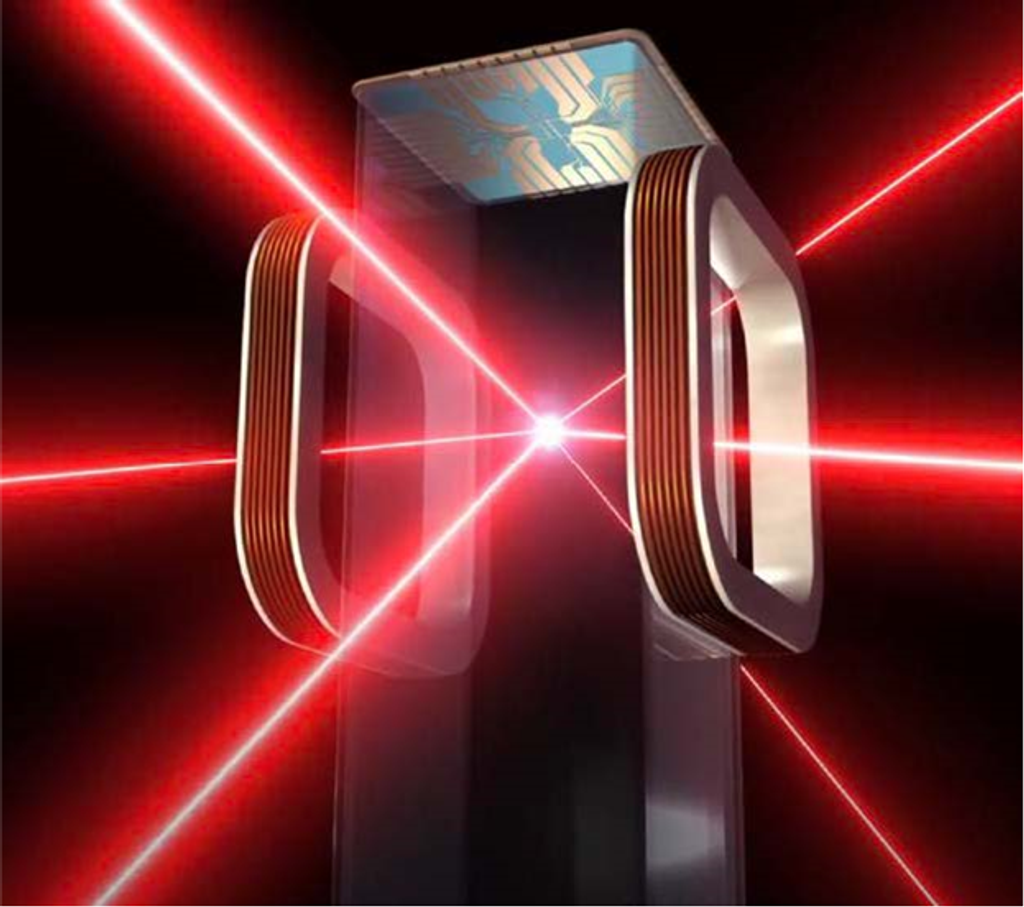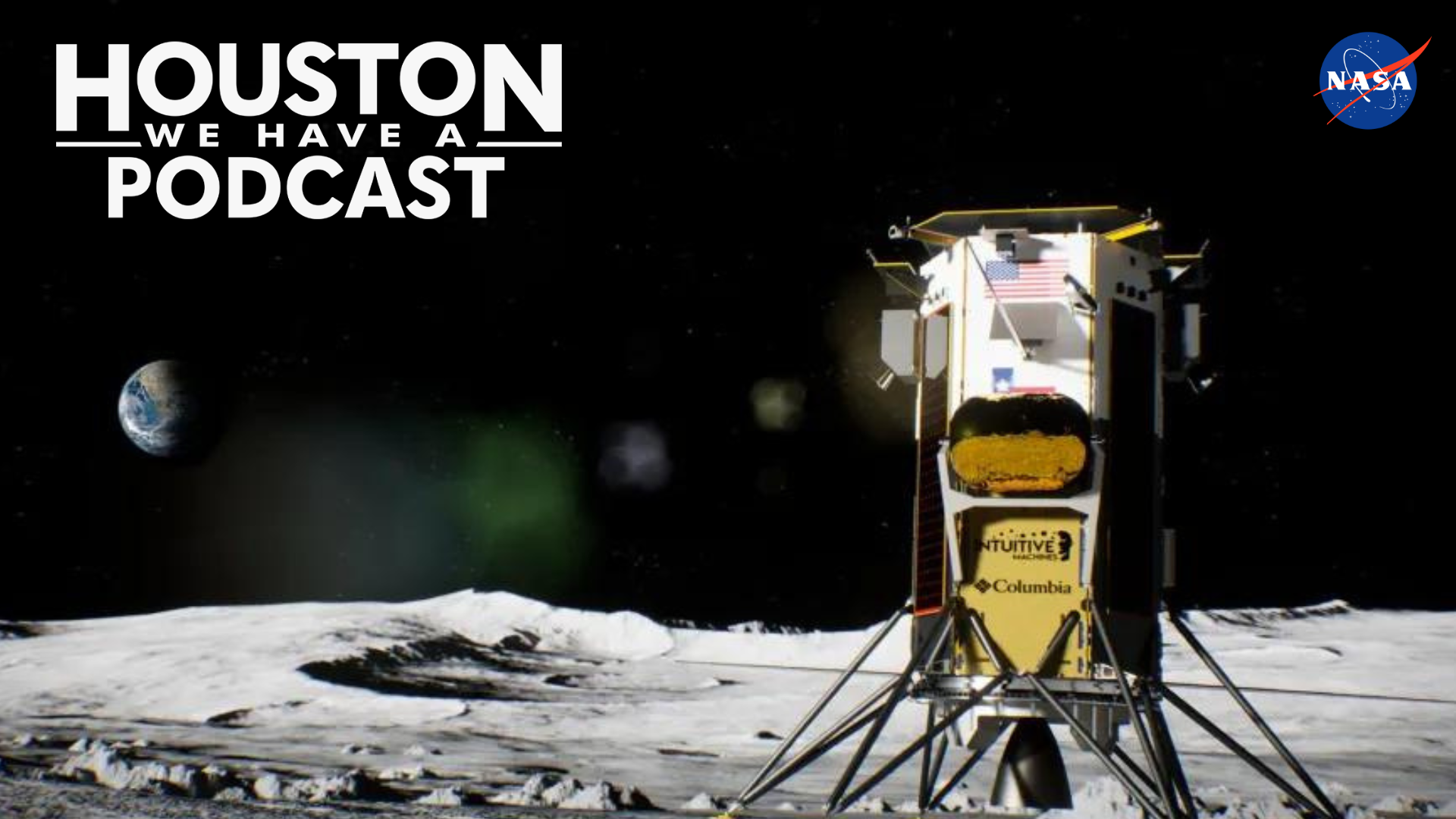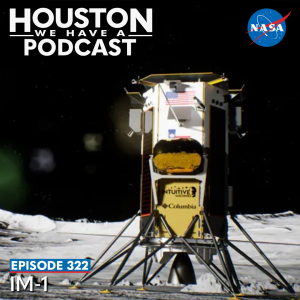
From Earth orbit to the Moon and Mars, explore the world of human spaceflight with NASA each week on the official podcast of the Johnson Space Center in Houston, Texas. Listen to in-depth conversations with the astronauts, scientists and engineers who make it possible.
On episode 322, NASA and Intuitive Machines experts discuss the science and operations behind the IM-1 mission ahead of its journey to land on the Moon’s surface. This episode was recorded on October 23, 2023.

Transcript
Host (Gary Jordan): Houston, we have a podcast! Welcome to the official podcast of the NASA Johnson Space Center, Episode 322, “IM-1.” I’m Gary Jordan, I’ll be your host today. On this podcast, we bring in the experts, scientists, engineers, astronauts, all to let you know what’s going on in the world of human spaceflight and more. NASA is headed to the Moon under Artemis. NASA is working with several American companies to deliver science and technology payloads to the lunar surface. The initiative is called Commercial lunar Payload Services. In short, NASA hitches a ride on a lunar lander, owned and operated by a commercial company to deliver unique science experiments and technology demonstrations that we’ve been dying to test out on the face of the Moon.
Launching this month is a mission called IM-1. It’s a commercial mission from the company Intuitive Machines, using their lunar lander called Nova-C. It’s launching on a commercial rocket, the SpaceX Falcon 9, and it’s landing on the Moon to deliver stuff, science and technology, a lot from NASA, but also quite a number of experiments from commercial industry and universities. On this episode, we sit down with Intuitive Machines’ Chief Technology Officer, Tim Crain, and NASA Project Scientist for the IM-1 mission, Susan Lederer, to understand more about this particular mission: the lander, the mission profile, and of course, the science and technology aboard that, very shortly after launch, is scheduled to land on the Moon. With that, let’s find out more on the Commercial Lunar Payload Services mission. IM-1. Enjoy.
[Music]
Host: Tim and Susan, thank you so much for coming on Houston We Have a Podcast today. It’s a pleasure to have you.
Tim Crain: It’s great to be here.
Susan Lederer: Thanks for having us.
Host: Alright. We are going to talk about IM-1, but first I want to get to know who you guys are because why we picked you to talk about IM-1. This is a very cool mission and a very unique type of thing, but I want to know kind of what led you to where you are. Tim, why don’t we start with you? You are chief technology officer. This is a sort of a relatively new role where you promoted recently?
Tim Crain: It’s a new title for the same job.
[Laughs]
Host: But it sounds cool.
Tim Crain: It does sound very cool.
Host: Chief Technology Officer, congratulations.
Tim Crain: Thank you. Very pleased to have the title.
Host: So what led you to become Chief Technology Officer of Intuitive Machines?
Tim Crain: Yeah, so I was a civil servant at the Johnson Space Center for 13 years working in advanced mission design and then when we started the Constellation program, I was the Orbit Mode Team Lead for what became Orion. And we were working towards returning to the Moon, very exciting. It was our Apollo, right? So all of the great stories and the tales of the original Apollo program, it felt like we had a chance now to put our own stamp on returning to the Moon and taking the next step. Very excited about that. But history has a funny way of taking its own course. The Constellation Program got canceled. I had the opportunity to work on a program called Project Morpheus where we developed an experimental lunar lander with the great Jon Olansen, who was our project lead. And I’m teasing Sue a little bit because they have a connection. I’ll let her talk—
Susan Lederer: My husband.
[Laughs]
Host: Okay. We’ve had him on the podcast very recently. Very good. Very good guy to talk to.
Tim Crain: Yeah, John’s a good friend and a mentor. But we really cut our teeth on a fast moving development project, and it really wedded my appetite for what a team of engineers could do on shorter timeframes than it seemed like we were doing at NASA. The Moon was out of favor. So I joined forces with a number of other like-minded engineers and we started Intuitive Machines in 2013 as a think tank, basically with the idea of taking NASA human spaceflight engineering methodologies and know-how, and applying those out commercially in aerospace, but also in medicine and in energy sectors. Cause we thought that ideas that were emerging at the time, like big data, that was very similar to concepts we knew, say, like large data, Monte Carlo analyses. So a lot of the things that were happening commercially, we felt like we spoke that language with a different accent, if you will, based on our experience at NASA. And since the Moon was no longer a destination, and we kind of had our heart set on it, we went out into the public sector and worked a number of problems for about five years. Didn’t fall in love with any of them though. So we developed automatic IV insertion devices. We built a drone that flew in Antarctica. We worked on how to more efficiently stop subsea well blowouts, you know, we did all kinds of incredible things. We didn’t fall in love with any of them.
Then the Moon became a strategic importance to the United States. NASA established the CLPS program, in part as a way of shaping the norms of behavior cislunar space. So could we go out and commercially show that we can lead the exploration and development of the Moon? And that was CLPS program. We looked at that as a company and decided that, hey, let’s dip our toe in the stream of lunar exploration again. And we got pulled right under the current, and it’s pulled us along. We pivoted the whole company in 2018 and are all in on lunar transportation, lunar communications, lunar development, and work with customers such as the CLPS program, but also, we have other customers at NASA, and not at NASA who are interested in transport and basically logistics to the Moon.
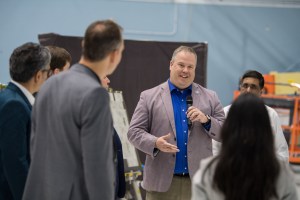
Host: I think one of the interesting things about this is we’re going to talk about CLPS and we’re going to talk about exactly what you’re saying, that interest in the Moon and why there is this national drive. But just because there’s a national drive doesn’t mean everybody’s on board. But what you’re finding is there is a lot that we can do on the Moon. And so we’re going to get into that for sure. Susan, now how did you end up in the world of CLPS?
Susan Lederer: In a very circuitous way.
Host: I can’t wait to learn.
Susan Lederer: So I’ve not taken a standard path, but my original degree in astronomy and astrophysics was really as a standard astronomer. So my undergraduate degree was in physics and math, followed by a master’s and PhD in astronomy astrophysics, and really going to telescopes, taking data of comets and asteroids. And then eventually found a postdoc position as I was finishing up my PhD working with NASA. But again, looking at comets and asteroids with telescopes. And then after my postdoc finished, I went and became a physics professor and taught physics for half a dozen years. And about the time that I was going on sabbatical, it turned out that there was a position that opened up with NASA to be a full-time NASA scientist, which, how can you turn that down? I mean, how can you not be entirely intrigued working for NASA as a scientist? So of course, I applied for the job and was very fortunate to get that position. But the work that I was doing as a NASA scientist wasn’t just using telescopes, it was also working in the laboratory, designing different laboratory experiments, building a telescope in the middle of nowhere on an island called Ascension. If you’ve never heard of it, it’s halfway between Brazil and Africa. And then eventually working on some DARPA projects, developing instrumentation. So that’s kind of the path that then led to looking at an opportunity to become a project scientist with the CLPS program. And with CLPS, my job is largely working with other groups of people who are designing instruments that will be flying to the Moon. So if you’re going to design an instrument and have some sort of world working with a bunch of brilliant people to be able to go and explore this place that we haven’t been to in decades, on the surface walking around, I can’t imagine something that’s quite as exciting as that.
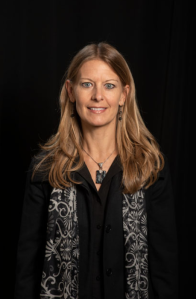
Host: Wow. So, you shifted from the role of observing, right? The telescopes and being on the ground. Now you’re a part of that mix. In terms of the instrumentation, when you make that shift, what are some of those things you have to consider from the observing and collecting to, okay, what do I want in an instrument that’s going to be on the Moon? There’s got to be some differences.
Susan Lederer: Well, there’s big differences. As a scientist, it’s all about collecting the end data and analyzing it to understand the science. The role that I’m in now, there’s so many elements of engineering and design and understanding how to build things in order to get that end data. So having the role as the scientists of understanding what the end goal is helps you to better design what the instrument is. So my role is not to actually develop the instruments directly, but to work with each of the teams that are developing the instruments to make sure that that marriage between the engineering design and the science output maximizes the science that we can get returned out of the different instruments that we’re sending to the Moon.
Host: Yeah cause ultimately you have to have these instruments on a lander. A lander on the Moon. And this is where we’re going to get into our discussion about CLPS, because the way that we decided to get these wonderful scientific instruments on the surface of the Moon was by way of commercial companies, owning and operating the vehicles, actually doing that. And that’s an interesting approach to getting scientific payloads on the Moon. And so Susan, I wonder if you can enlighten us on what is this program, Commercial Lunar Payload Services?
Susan Lederer: Absolutely. So the hope is that this is just the start of hiring commercial industry to help NASA evolve in how it’s really doing its business. So in the start, NASA builds everything. They own everything, the cost is on them, and it’s all very new. And there are so many things that require a huge amount of task force and money, right? With all the Apollo landers that went, there was just NASA that was doing this.
Tim Crain: There was no space program or industrial base to pull from. So a lot of that equipment was either re-tasked aviation equipment or a novel invention just then. So in the early days, as Susan says, there was nothing to draw on. So everything was new and from scratch
Host: To solve a single customer’s needs, right? It was the customers of NASA. NASA wants to do this. Okay, let’s design something for meeting that need.
Tim Crain: And to transport it as well. Those are the first boosters we built. The first spacecraft we built, even if they were robotic, there wasn’t a reach back into a commercial industrial base to go, “You know what? I think we could re-task this.” If you look at today, we have commercial satellites that fly in low Earth orbit all the time. We have flight computers, we have cameras, we have radios.
Susan Lederer: And we have ways to get astronauts up to the space station now that doesn’t rely on NASA as well.
Tim Crain: That’s right, NASA has evolved to commercial cargo resupply on the space station, now commercial crew transfer on space station. So to come out and then say, “Well, let’s put out a tender and see if companies can respond positively to how we will now take our improved industrial base that is space capable, even beyond the things that NASA does, and how might we solve the problems that the scientists need for transportation?”
Host: So I guess part of the reason for landing on this solution, commercial solution, was there may have already been a stronger infrastructure in place than maybe perhaps, you know, 50 years ago we were in the Apollo era. Now, if we want to put out a call for commercial companies, we can, because companies are able to answer the call.
Susan Lederer: Correct. And for NASA, the goal is not to keep NASA as the sole customer forever, right? We create the base, and then the hope is that commercial industry takes over where we started and pulls from that. So that instead of being something that you’re really starting at the ground up, that in the future we’re creating this commercial economy that’s doing that at a much better price and doing it at a much greater volume. So instead of having one spacecraft that’s sent to the Moon a decade, we’re now having one a year, instead of having five or six payloads that are being sent on a single mission, now it’s 12 different missions each have five or six payloads, just on the NASA side, but addition, potentially five or six on the commercial side, so much greater volume of instrumentation that can go to the Moon.
Host: Which is of course a win for NASA, right? We get more stuff on the Moon. Great. But then, you know, Tim, you were saying Intuitive Machines, in 2018, I believe you said Intuitive, Machines shifted the focus to the Moon because you must have seen something in terms of this may be sustainable in that we don’t have to rely on just NASA. This is something that we can find other customers to do.
Tim Crain: Absolutely. And not only did we feel that it must be sustainable, but this was the only way it was going to happen. For example, there was not a commercial clamor for, “Please somebody take us to the Moon,” in part because nobody thought it was possible. In order to go to the Moon, you have to get a booster and organize tracking stations and work payload integration and have a mission plan and build a spacecraft, there’s a lot that goes into that. What we found was after we won our first CLPS task order, you know, we had payload space available, and so we went out and talked to other potential customers, say call this year one. And we got a lot of scrunchie faces and people said, “Wait, I don’t understand what you’re saying.” Well, we have a mission to the Moon, but we have payload space available. Would you like to buy some? “I’d never even thought of that,” was kind of the response. You know, we’ve never conceived of such a thing.
So we come back in year two, you know, at the trade shows and at the conventions and on panels, and all of a sudden, “Hey, we’ve been thinking about it. Now how does this work again?” And so, okay. Well, we have a contract with NASA, they pay for part of the payload space. We have remaining payload space that we make available to other customers. Okay. Alright. “And you would sell that to us?” Yes, we would. Okay. Thank you. That was year two. And so then we started seeing clients take that back into their budget cycles and to write proposals for here’s my 15 or 20-kilogram payload where I could do some really important things at the Moon or things that were important to me on the Moon. You know, maybe they’re not as scientifically profound, but maybe it’s a technology demonstration or a commercial development of some sort.
So in year three, we started getting requests of, “Hey, we’re putting in a proposal for our own payload. Would you write us a letter of intent that if we win, you’ll fly us to the Moon?” We never would’ve gotten there if it hadn’t been for CLPS opening the door and providing a little bit of a build it and they will come. So it’s kind of interesting, right? Nobody was thinking about going to the Moon almost as a ride-share until that opportunity existed. And then it took time for the organizations to kind of, okay, what might we do? And now, we’re really looking forward to not only flying the three missions we have on the books but when do we make the leap to a larger lander or accommodate more payload.
Host: That’s right. So that actually was going to be the sort of the lead into the next question is, I wonder when you’re having these, you threw out this idea, right? Hey, we can bring something to the Moon. Are you at a stage where you have some level of maturity in your lander where you can say, “This is the size of the payload, these are the power constraints.” Are you at that level there? Or are you just sort of throwing out an idea and then it matures over time?
Tim Crain: We are there for Nova-C, which is our first lander and it carries between 100 and 130 kilograms to the lunar surface. We can provide about 600 watts of power, but that’s the first-generation design. So what we’re really looking for now is when does it make sense for us to make the leap to Nova-D, which can do 500 to 2,500 kilograms to the surface of the Moon? And now you begin moving into a mode where, you know, if you had a shipping company taking goods from New York to LA and you only had a two-seat car, there’s only so much payload you could carry. And you’d have to charge a premium. But then if you had an 18-wheeler with a full trailer, you could greatly reduce the cost per customer and provide a lot more transportation service. That’s very analogous to what we’re doing, where we’re saying, “Look, we’re, we’re learning our technology, we’re getting our operations regularized so we can launch on time every year.” Once we achieve that, how do we then make the transition to a more capable lander that can do NASA payloads, but then even more non-NASA payloads?
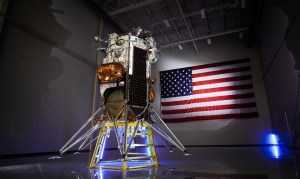
Susan Lederer: And this kind of brings us to the other point is that we, NASA, are a customer of Intuitive Machines. It’s not that Intuitive Machines is a customer of NASA. The mission is owned by Intuitive Machines, not NASA. It’s their mission. And we are part of their mission. We are a customer, they have many others.
Host: So let’s investigate the how this works then. If it’s not a NASA mission, it’s not say, “Hey, I need a ride to the Moon.” How does it work to incentivize a company to go ahead and start designing Moon landers with whatever we as NASA are putting out? So I guess the question is, what are we putting out that says, “Hey, I have this need, I have these things that I would like delivered to the Moon, somebody please ship them for me.” And then companies come and propose the solution. Is it sort of like that?
Susan Lederer: It really is exactly like that. We have call for proposals. We call them RFTPs, request for task proposal, where we say, “Hey, we have selected a suite of payloads that we, NASA, think is important for the baseline understanding of some of the key portions of either science or technology in preparation for the Artemis mission coming up.” And so we want this set of payloads to go to the Moon, we want it to go to this particular location. So we work with the payloads and say, “How much power do you need? How much data do you need to have come back? How big is your payload? What are all of the specifics on the engineering side?” And then we put that in a proposal that we put out, and then companies will actually respond to that proposal to say, “Hey, we can take your payloads to the Moon for you, and this is how we’re going to do it, and this is how much it’s going to cost.” It turns out that we then are creating a way for NASA to do very high-quality science at a lower cost to NASA, but also create this industry for commercial.
Host: Okay. So the part of the call is for the delivery service, and it’s not necessarily the development, the design development of the landers themselves it’s just I want this shipped, you guys have to figure it out.
Tim Crain: That’s right. We basically had to have the wherewithal to say, “We have a program to develop the transportation systems that will answer that call”. And then it was on, especially in the early proposals, we would have to write in sections of what were our risks. So they didn’t tell us what our risks were, but we had a payload specification, okay, this is the system that we we’ll use to transport those and meet those specifications. And here are the risks in our development that you should know about. That’s included in our proposal. And so NASA had a lot of insight into not only what’s the cost, but how are they going to go about it and what’s their schedule, what’s their technical solution, what’s their risk items? And that’s an interesting new development because it wasn’t NASA saying, “Build this thing and I’m going to evaluate its quality.” It was, “Tell us what you’re building, how it answers the need, and why we should have confidence in that solution.” And so it was on us as vendors basically to write that story in a competitive environment for NASA to evaluate.
Host: Right. Yeah. Because I guess that’s something that NASA wants is a competitive environment, right? Not a one-off solution. We’re trying to create, dare I say, an economy.
Susan Lederer: Exactly. Right. That’s the goal. And already we have eight primary task orders is what we call them. But we have, you can think of it as eight different manifests of payloads where we have contracts with commercial vendors and we have three more calls that are in the process of either being let being evaluated or being put out for a call for those vendors to respond to. So we’re looking at in the next, you know, half dozen years having a dozen launches, distinct launches, to the Moon instead of one over the course of a decade.
Host: There is that many payloads that NASA is looking at. There’s that much science to do.
Susan Lederer: Science and technology that we’re working on. So we have a suite right now of payloads, somewhere between four and five dozen payloads that we have either already assigned to task orders, meaning to a particular vendor’s mission, that we know where they’re going, or that we are looking for a home for a future mission. Four to five dozen. It’s a lot.
Host: Wow. That is a lot.
Susan Lederer: Which means that we have the ability to evaluate a lot of different kinds of science and a lot of different kinds of technology.
Tim Crain: So interesting factoid, the surface area of the Moon is approximately the same as the surface area of the continent of Africa. And we’ve had a dozen landings as humans overall between the Apollo landings and then the robotic ones. Imagine if you could only take 12 visits for a few days at a time to something the size of Africa, how much there would still be to learn about what is there. We’ve barely scratched the surface. So even though four or five dozen more sounds like a lot, my perspective is we’re catching up after 50 years of not having sent any.
Host: That’s right. Yeah, cause I think there’s difficulty with landing on different parts of the Moon too, right? So if you land in the equatorial region, like as hard as landing on the Moon is, I think from a trajectory standpoint, it’s a little less complicated than say, landing on the Poles.
Tim Crain: The Poles have some scary aspects to it, I’ll say. They’re rugged.
[Laughs]
Host: And we can get into that a little bit too. But yeah, if you’re only seeing certain parts, you don’t have the full story. You know, what if in your whole tour of Africa you missed the Great Pyramids?
Tim Crain: Sure. You never saw the Nile.
Host: Never saw the Nile. Exactly. Yeah. There’s huge parts of the story that you’re missing.
Susan Lederer: Or you only ever landed in the Sahara Desert. And so you assumed that there was no water anywhere on the surface.
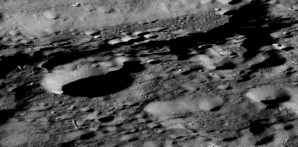
Host: That’s right. Oh, well then this whole continent mu must be desert. Exactly. But there’s so much more story to tell. Very fascinating, interesting perspective. So, just to close the loop on the government speak, if you will, the task order. And I think this is a really interesting way just to sort of round it out cause I think you’ve described it really well, Susan, is we’re not buying a mission. It is deliver these payloads. That is the task order. It is up to the companies to come up with the solution. And that solution is the company’s mission, which in this case would be IM-1.
Tim Crain: That’s exactly right. And then we’re encouraged by the philosophy of the program, not necessarily in the contract, to accommodate other customers outside of NASA as well.
Susan Lederer: And interestingly, part of the evolution goes from the early task orders where our goal is to really help companies figure out how do you land safely on the Moon to begin with. And so we have payloads that are a little bit smaller, less complicated, working really more on the technology to understand, you know, how are you using your fuel in your tanks and how do you land safely with a Navigation Doppler Lidar-type instrument, to in the future, using much more complicated science payloads in things that we call PRISM calls. And a PRISM call is a NASA program where it’s not just NASA instruments, it’s actually instruments that are developed by commercial or academia or NASA scientists as a group that have applied to a separate call that NASA has out to develop the instruments.
Tim Crain: It’s almost the complimentary program to the transport.
Susan Lederer: It really is.
Host: Oh, okay.
Susan Lederer: And interestingly, IM is a really good example of, they have one of the early task orders, and that’s IM-1, where they’re really showing we can land on the Moon. And then they have, IM-2, where the goal is to land a drill as well as something that can detect volatiles. Volatiles is just a very fancy way of saying things that evaporate easily, like water and ammonia and methane, so that there can be another mission called VIPER. And that is actually a NASA mission where once that rover roves off of the surface of that lander, it’s going to go look for volatiles at the (South) Pole. And then the next step after that of doing the bigger proving of the technology, like IM-2 is doing, their IM-3 mission is one of our great PRISM calls. So it’s called CP-11 in NASA speak, CLPS PRISM. That’s the first PRISM call. And so their third mission is taking very important science that NASA is concerned about. So they show kind of that evolution of the CLPS program just in their first, second, and third missions alone.
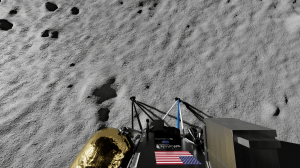
Host: Yeah. Just to reiterate in my own words, it sort of sounds like the original task order, a lot of the early science is better understanding landing on the Moon. And a lot of science that can ultimately help us with operations and long-term operations. Whereas things evolve over time, now we’re getting into like science, now we’re getting into the science of the Moon, lunar science, volatiles, understanding a lot of those things, that is very important to the Artemis program in the first place is just investigating the lunar Surface. And so we can send payloads not only to just learn how to land on the Moon, because at that point it’s in the way proved it. You have demonstrated that you have landed on the Moon. Now you can get to some really cool lunar science.
Susan Lederer: Yeah. Step one, stick the landing.
Tim Crain: Absolutely. That’s right.
Host: Very important.
Tim Crain Yeah. We’re excited about it though. But you know, we look at our IM-3 mission, there’s a magnetic anomaly on the surface of the Moon that we don’t understand how or why it’s there. So we’ve been watching this for, you know, over 50 years, but we don’t have any data on that magnetic anomaly. And so we’re pleased in that mission to be taking NASA payloads that are going to provide the answers for how did this happen? You know, what is this thing on the surface that we don’t understand?
Host: More understanding, more about the Moon, maybe more about our planet as a whole too, just in the process. Very cool stuff. Let’s talk about IM-1 and specifically, the Nova-C lander. Cause one of the things we talked about was we have these payloads and Susan you said, here are some payloads that we would like you to deliver to the Moon, please. And Intuitive, Machines came up with a solution. That solution is the Nova-C Lander. So it had all those requirements that Susan was talking about. This is the size of our payloads, this is the power, here’s what we need to make sure that those instruments will operate correctly. All we need you to do is make sure they operate correctly and then safely land that on the Moon. So describe Nova-C and why that’s the solution for that call.
Tim Crain: Nova-C is unique in the CLPS field because we have a cryogenic methane propulsion system. All of our competitors use a more traditional, kind of Hydrazine-based propulsion. The difference between that is those hydrazine approaches, you turn your engines on and off very quickly and that’s how you steer and control the vehicle. Liquid methane, we’re using it, you turn it on and then you very slowly turn the knob to change the power level. So it’s a different approach. It has a little bit more power density, if you will, in the fuel. But there was a little bit of development risk. And so we’ve been tracking as we’ve made CLPS proposals. Our first proposal, we had a multi-step risk reduction process. And then when we put our second proposal in, we’d done about half of those and we said, well, we have the other half to go. And it was nice when we did our CP-11 proposal to say we’ve finished all the risks and so we’re ready to fly. But what that basically means is the vehicle looks a little bit different too. It’s not a flat squatty vehicle. It is a hexagonal PRISM that stands about 14 feet tall. Inside is mostly a liquid oxygen tank and a liquid methane tank. And that part of the vehicle doesn’t change from one flight to the next. Really, the most important thing about landing on the Moon, regardless of how you do it, you have to have about 1800 meters per second of what we call Delta-V, or change in velocity, to go from being in orbit around the Moon to not moving on the surface of the Moon, stationary.
Host: The most important thing about landing on the Moon: landing on the Moon.
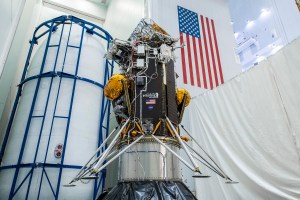
Tim Crain: Landing on the Moon. And you have to have a propulsion system with enough impulse to do that. And so ours is a unique in-house design developed based on technologies NASA had invested in for years. So we leveraged the work that had come before us, but we basically have three life cycles on our vehicle. When we launch, we will serve as basically a transit spacecraft. So we’ll provide power, health monitoring, communication to all of our payloads. We’ll make small course adjustments there along for the ride. And we are getting into orbit around the Moon. Then we become a lander. We orbit the Moon, we do a very large maneuver to descend to the surface. We land with precision, and that’s the second phase of the Nova-C life.
But once we’ve landed, not only are we taking these payloads to the surface for NASA, we then become a power and data hub, right? So we provide the communication link back to Earth through our own ground stations. The payloads communicate with us. We provide power, heating if they need heating, cooling if they need cooling. The Moon is a very harsh thermal environment. In some cases we even have a payload on IM-2, we’re providing computational resources cause we have the best computer for 250,000 miles once we’ve landed. And that’s really the way that whole thing evolves. The vehicle’s completely autonomous. So we provide some systems monitoring support, small course corrections, but the vehicle does everything on its own. And we’ve been testing it both in simulation and on the vehicle for, for some time. We’re excited to see her fly.
Host: Fantastic. Very cool. I think we all are too.
Susan Lederer: We definitely are. We’re ready to go.
Host: Yeah. Ready to go. Exactly. Now, of course, that is the lander that is delivering. I think the primary purpose of this, I don’t necessarily want to call it a secondary purpose, but a huge part of this program is of course developing an infrastructure, commercial infrastructure, of vehicles that can take wonderful payloads. You said dozens and dozens of payloads and NASA payloads to the Moon. Of course, there are the commercial payloads. But let’s get into the IM-1 payloads now. Susan, you said what we are ultimately taking on this mission, a lot of it is understanding how to better land on the Moon. So what are some of the things that we can see? What are some of the instruments on IM-1?
Susan Lederer: So we, NASA, have five different payloads that we are sending on IM-1. The first is very much a collaboration with IM, it’s a fuel gauge, if you will, where we put an antenna inside their tanks to see how their fuel is being used. So that’s going to help for them to understand better what their lander does. And it helps us also in understanding our technology as well.
Tim Crain: And that’s something that might not be obvious is to, why would you need an antenna to know how much fuel you have in the tank? But we’re floating in zero g and so the liquid fuel in our tank is floating around. In our cars, you have a float in your gas tank that floats cause gravity’s pulling all the fluid to the bottom, but we don’t have that in space. So understanding precisely how much liquid you have in your propulsion system left to be used is still relatively new. And we’re using NASA technology to help us with that.
Host: It’s been a lot of estimates up and this will just help with that precision.
Tim Crain: That’s right.
Susan Lederer: Yeah. So that’s RFMG, Radio Frequency Mass Gauge, as I believe with that team. We love our acronyms.
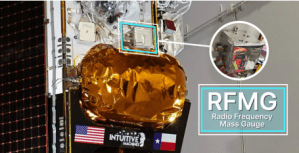
electronics installed on the Intuitive Machines
Nova-C lander. Credit: NASA/Intuitive Machines
[Laughs]
Host: There’s a lot coming up, yeah.
Susan Lederer: How many acronyms can we come up with?
Host: I think all of them are acronyms.
Susan Lederer: Yeah, they really are. And in fact, so the next one is NDL, which stands for Navigation Doppler Lidar (for Precise Velocity and Range Sensing). And again, it’s measuring the rate of descent and the distance to the Moon. And so that’s using a Lidar, which is laser technology, going to the Moon. And I believe you’re working on your own technologies with LIDAR as well?
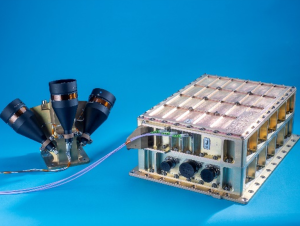
Tim Crain: We are. We have a different Lidar technology, but the one from NASA has some unique properties in it. It measures the velocity very, very accurately. We measure our velocity right now optically by using a change in images. And that’s great as long as we’re always approaching on the illuminated side of the Moon. And so future deliveries may require a nighttime landing or it just might require that we come in from the night side. And so technologies like the NDL will enable us to be less lighting-dependent than we are right now.
Host: Yeah, even you have a lot of shadowing constraints on the Poles too, which I’m sure would affect that. Very, very interesting.
Susan Lederer: Absolutely. So our third is called LRA, and that stand stands for a Laser Retroreflector Array. And so that’s something that’s so small, it fits in the palm of your hand. But then if you have a spacecraft in orbit, it can actually use a laser and laze down to the surface. And if it hits that Retroreflector, that laser beam bounces back. And you can very, very accurately measure exactly where you are on the surface of the Moon. So we have these on many of the task orders on many of their missions so that we can figure out the array of where those landers are so that we kind of have a little bit of a roadmap of where all of our landers are located.
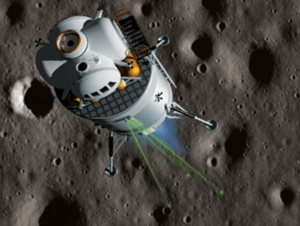
Tim Crain: It’s a little bit of the first steps towards a sustainable infrastructure on the Moon. Those laser reflector arrays are going to be navigational beacons as well. If you know where we put the lander and you see where the beacon is reflecting, you really can begin to hone in your own navigation solution by using that reference. So leaving behind pieces that are useful beyond our own mission that support additional missions is really how you begin building up a sustainable infrastructure.
Host: Oh, it can be independent of any power constraint or anything like that.
Tim Crain: That’s right. Once our land there ceases to operate completely, that asset will still be there until dust from the Moon covers it up a thousand years from now.
Host: Wow. Alright.
Susan Lederer: It’s just a passive instrument that sits on the surface. It’s basically got some little cubes inside that allows the light to bounce right off it. It needs no power at all.
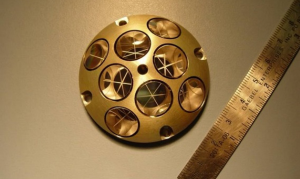
Host: Very good. Keep using it until IM-1000. That’s awesome.
Susan Lederer: That’s exactly right. That’s exactly right. And then that also leads into our fourth payload, which is the Lunar Node 1 or LN-1. And this is really interesting because I think everybody who’s probably listening to this podcast, even the small children, understand GPS service. In order to figure out where you’re going, right, you want to have that GPS node. So we now need to create a suite of GPS type nodes on the surface and LN-1 is that first step of creating a way to send signals back so that we know where things are on the Moon and to create that sort of GPS service for things coming in as they’re landing.
Host: First step of lunar GPS, I guess.
Susan Lederer: That’s right, lunar GPS. So they’re actually going to be sending signals back to radio telescopes on the surface of the Earth to confirm that they can get their signals sent between the Earth and the Moon as well.
Tim Crain: Yeah. The lingo for GPS-type services is PNT, Position, Navigation and Timing. And so GPS or Galileo or mania, the Russians have a system too, those are all GNSS, global navigation services, but they’re all instantiations of Position, Navigation and Timing based on the signals. So LN-1 will be a demonstration of some PNT capability at the Moon, and then we’ll continue as we go and take more satellites and more landers up to put more PNT assets in place too.
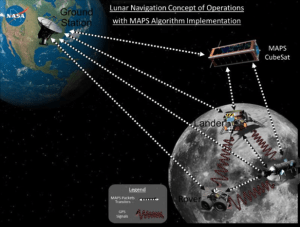
Host: Very cool.
Susan Lederer: So the next payload is called SCALPSS. And SCALPSS (Stereo Cameras for Lunar Plume-Surface Studies) is there to really understand as you’re coming down the engines of course are they have their fuel and it’s creating a plume. And that plume itself is then going to hit the surface and it’s going to cause the dust to really churn up and create a big plume of dust. And so it’s going to be taking a set of cameras and looking down as that plume of dust comes up. And that’s going to help us in a couple of ways. One of the ways is that it helps for future landers to be developed to better protect against the dust that’s being churned up. But there’s also a second reason, which is near and dear to my heart as a scientist, which is we really want to understand the surface of the Moon and the dust of the Moon. So it has this dual role of being both science and technology.
Tim Crain: Yeah. I mean really our engine plumes aa sand blaster if you will, because it’s been a big pressure wave out underneath it and there’s no atmosphere at the Moon. So on Earth, you would see a billowing cloud that would circle back up around the lander. Well, those particles are going to shoot out away from the lander. And SCALPSS will be able to very high rate, observe the trajectory of those particles, and then do science based on that to see, hey, we know the engine’s very well characterized. We know what power level it was at. We know what thrust level it was getting. So if we know that in the altitude above the surface as we observe those particles on their trajectory, what does that tell us about those particles in the surface of the Moon as we’re, you know, scouring it away with our engine during terminal descent.
Susan Lederer: So we can see a bit of what’s underneath all that loose dust.
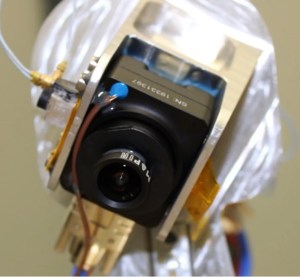
Host: Is there something interesting about this particular landing site for IM-1 that would kind of give us unique insights? From a geological standpoint that would give us unique insights into like the regolith makeup of that particular site?
Tim Crain: I think that they’re all interesting.
[Laughs]
Susan Lederer: They really are.
Host: That’s a good answer.
Susan Lederer: Yeah. So one of the great aspects of the IM-1 mission is that we’re aiming to go more and more South. And so the Chandrayaan-3 landed at 70 degrees. It did South. We’re going to beat that record, aren’t we?
Tim Crain: We’re going to be about 80 degrees South.
Susan Lederer: Yeah. Oh, excellent. So we’re getting even closer to the South Pole. And so now we really start to understand what the South Pole geology is like. And that’s really good again, for understanding the science and what the Moon is like at the South Pole because of course the Artemis base camp is planned to be at the South Pole. So it helps us to really start to understand the geology of where the astronauts are going to end up landing on the surface of the Moon.
Host: Wonderful. Broadening our understanding of Africa, right?
Susan Lederer: Exactly.
Susan Lederer: Then the last payload that we have is called ROLSES (Radio-wave Observations at the Lunar Surface of the photo Electron Sheath). And this is a pure science payload, yet has applications as well to the Artemis mission. So its base goal is to understand a combination. It’s both really. It’s just four. It’s four antennas and they are collecting radio data. So the pure science side of things is to understand and observe the Sun, the Earth, the planets, and the Earth as a planet, not the Earth as hey, this is where we’re coming from, but really understanding it as its own unique planet. But then we also have the additional role of having the ROLSES understand the photons of the Sun coming and hitting the surface of the Moon and actually creating a charged particle, kind of an environment of the dust. So anybody who’s walked around in a really dry area and you know, walked along carpet, and then you go and you touch a metal service and you get a shock, right? It’s because electrons have been churned away from the carpet. This is a similar idea, only it’s sunlight that’s causing this to happen. And so this helps us then better understand how that dust is going to adhere to the spacesuits of the astronauts in the future. So even though it’s supposed to be just a science payload, we can make everything. We got there, we got additional technology,
Host: Couple steps. Yeah.
Tim Crain: And neat thing about ROLSES, that our lander geometry favors it’s four antennas that they’re whip antennas that deploy after we land. So they’re kind of like compressed and then the a circuit releases them and they extend out from later, but they do it at four different heights. So you’re going to get the charge particle science at a very close to the surface measurement point, and then higher and higher and higher. So they’re going to get built in kind of this gradient of how does that charge particle field change from the base of our 14 foot tall lander to the top of it. And so it’ll be interesting to see is it uniform, does it change after a couple of meters? All of that stuff will be good for spacesuits, habitats. You know, understanding how we build on the Moon will be good information.
Host: Very, very good. Now you said Susan, dozens of experiments that we could have chosen from, we picked these five for IM-1.
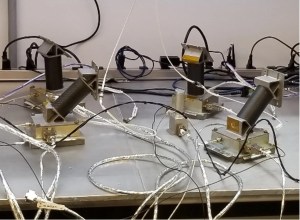
Susan Lederer: We did. Why these are really good for a baseline of understanding better how to land safely as well as to create a baseline for both the science and technology that we need for the Artemis future generations to go, not just to the Moon, but going to a polar location. So this is a big deal going to the South Pole. It’s a big deal for their first mission to do this kind of mission as some baseline for Artemis.
Host: Yeah. We talked about, you know, part of the hard part about landing on the Moon, is landing on the Moon, right? So of course, the science that comes from this, if we have more confidence and more understanding about successfully landing on the Moon and what that takes, that just means more science. Cause we can just have more confidence and more landers. Very, very interesting. Now, of course, commercial lunar payloads, right? We mentioned this in the very beginning. We are not the only customer.
Tim, you mentioned this upfront, is you have this task order. Hey, these are the science payloads that NASA wants delivered to the Moon. And you said as part of the design, the solution which ended up being Nova-C for this particular mission was to get those payloads. You had some extra room. And so you ended up going out and soliciting opportunities for other companies through that progress of just planting a seed and eventually maturing in a mature instrument from a commercial entity to fit onto this lander. What are some of the ones that we can expect to see on IM-1?
Tim Crain: Well, some of them are going to be complimentary and very familiar to the payloads in particular SCALPSS that Sue was just talking about. We have EagleCam, which is a university payload from Embry-Riddle in Daytona. And it’s basically a cube of cameras that once we begin the terminal descent of our land, we’ll eject and then take a continuous stream of images as it tumbles, and then it’ll hit the Surface. And then when we land, we’ll interrogate it and pull back the images it took of the landing. And we will reassemble a movie watching the lander come down from a third person perspective, which no one’s ever seen before. The best we have is from the Apollo missions. You land and you set up a camera and you see them take off, but no one’s ever seen a lander land on another celestial body. So that’s very exciting for us, just from a wanting to understand how our lander did from the human aspect of I wanted to see it happen.
Host: My jaw just dropped when you were explaining that sounds—
Susan Lederer: Right. It really did.
Tim Crain: So cool. Right? It’s a very human thing. And then the scientists or are talking amongst themselves with Embry-Riddle about that imagery.
Susan Lederer: So we already have collaborations that we’re setting in place between the commercial Payloads and the NASA payloads because of the joined effort in wanting to understand what happens during the landing. And how great is, I mean, it’s one thing to kind of watch from the outside. It’s another to watch from the inside. Don’t you want both perspectives? And both teams are very excited about working with each other.
Host: A lot of the things you mentioned, right? The measuring, the distance, measuring the landing plumes, then like the speed of and descent of a lot of these payloads that are measuring all these things. Why not just get another perspective of that? Very interesting.
Tim Crain: Now we have a payload with Columbia Sportswear. Which is almost NASCAR-like in the way we’re doing that. So we actually have a Columbia logo and are flying their Omni-heat Infinity insulator on our lander to evaluate its application in space. That collaboration has been deeper and more fruitful than we could have possibly imagined because it turns out they’re really good material scientists who are interested in how to keep humans warm and comfortable on Earth. It’s exactly the same thing we want to do to our payloads, keep them warm and comfortable during the transit to the Moon. And so we began working with them on understanding how else we might apply their insulating technology. And then they got some ideas working with us on how to replay back some of the things they learned into their apparel line. So it kind of started out more like a sponsorship, but as we got into it, you know, there were some terrestrial material technologies that had never been considered for space applications before. And that dialogue has emerged from this opportunity in a way that we never had anticipated would’ve happened. So we’re very pleased with that relationship.
Susan Lederer: This is exciting because there are so many NASA spinoff technologies that we talk about. I mean, if you really sat down and looked at the commercial payback, right? An estimate that I saw some 10 years ago is that you would have a payback of $8 for every one that you put into an investment with NASA just from spinoff technologies, which is incredible. And now with the commercial industry developing, we’re starting to have the reverse happen. So I find that very interesting.
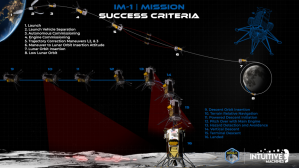
Credits: Intuitive Machines/Hunter Christian
Host: I think it’s interesting just to add on is the fact that you wouldn’t expect this to happen, I feel like we’re going to see that a lot more because Tim, you mentioned in the very beginning just planting the seeds of these universities, companies, that didn’t even know this was a possibility. I could think we can expect more unique solutions like that. Why put, you know, jacket material on a lunar lander? Well, there’s some decent applications that can be used for spacecraft for people here on Earth, and I can see us seeing more of that as CLPS continues.
Tim Crain: Yeah, and you know, innovation is a word that’s thrown around a lot these days. You know, everybody wants to be an innovator and oh, that’s very innovative. Right? A lot of times, I think we characterize innovation as an original thought that one person has. You know, I had the idea for this computer, or I had the idea for something. But a lot of times I really see innovation when people compare ideas and they get inspired by each other and go, “I never thought of that. Okay, I see what you did there.” What if you put my chocolate with your peanut butter? You know? And we come up with something better than either one of them together. So the more payloads that that NASA flies, the more payloads that we go out and find to bring into the fold, you begin getting these connections between people who maybe had not thought before, how their technologies, their scientific approaches might interact. And you do start stirring up this collaborative pot of innovation and seeing as we get more and more people, dozens of payloads planned, hundreds after that, habitats, more people working together and exchanging ideas, that’s where we’re going to see some really great innovation come out for developing the Moon.
Host: And so this is sort of where I wanted to lead the conversation through all of this was IM-1 is just the beginning. You are already even up top we were mentioning IM-2, IM-3 We were talking about the progression of the landers, of the different capabilities of the science. This can only evolve. So, we’ll wrap up with these ideas from each of you. Susan, starting with you is the importance of having this capability. And the reason we have dozens of different payloads that we want to bring to the Moon is because there’s that many interesting things that we can analyze. So why is a program like CLPS so exciting to think about the future of how we can get more science on the Moon?
Susan Lederer: The reason I think CLPS is super, super important and very interesting, not just as a scientist that’s interested in the Moon, it’s a really different shift in how NASA does business, right? So instead of us doing everything like we had talked about in the beginning, now we can have commercial industry stepping in. They can use their innovative ideas, not just what NASA has developed ourselves. And potentially we can then create CLPS for Mars, where now we have commercial industry stepping in and helping us better understand the surface of Mars so that maybe in the future we could even create a base on the surface of Mars, much like we’re doing at the surface of the Moon. Which really then leads into NASA’s whole concept of Moon to Mars program. So CLPS could be an excellent way to think differently in how we create that Moon to Mars connection.
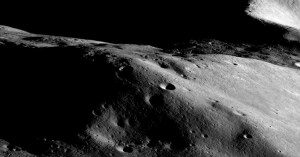
Host: Or companies, more customers, a general foundation of just understanding that this is actually something that we can do and you can use unique science, so bring us your ideas, whatever interesting idea it may be. Tim, thinking about that, you talked about in the very beginning, Intuitive Machines shifting its focus in 2018 because there was that much potential with focusing on the Moon, thinking about what’s to come for IM-1 and beyond. What excites you?
Tim Crain: Well, we touched on a little bit before when Sue was outlining how some of the science Payloads were going to inform some of the engineering of transport and landing. Moving to where the things we’re doing at the Moon are yes, answering the deep questions of how did it form and, you know, what’s the nature of our solar system and the interaction between the Earth and the Moon? Those are very important questions. But to also begin to answer questions of how would you do civil engineering on the Moon? How do you build a landing pad? How do you use the lunar regolith to make an igloo-like structure that will shield you from radiation? So these are questions that science also has to answer, but it moves us into a realm of we aren’t just understanding the Moon, we’re developing it. And how do we take the very best practices of development that we’ve learned here on Earth, take those with us to the Moon, leave some of the ones that weren’t as good behind and begin going, yes, this is how humanity’s going to put their footprint with a permanent presence on the Moon. We’re at the entry stage of that thought process and we’re already talking to mining exploration companies, to construction companies, to init resource utilization companies, ISRU, who are looking at the Moon now in a different way. And they’re saying, “Hey, that is a resource that we can use to develop our own fuel depots on the Moon to build our own transportation systems on the Moon.” And from there, we really can go out into the asteroids, to Mars, and humanity in a real way can begin moving out the solar system. We’re at the very beginning of that era and it’s very exciting.
Host: I think the uniqueness of each of your answers is very telling. Talking about the various perspectives that are equally exciting, just kind of shows how much there is here in the future. There’s a lot of different ways and I think it’s just exciting. Like how is this going to turn out? I don’t know. That’s actually equally exciting, right? We don’t know. We’re all building towards a future, but just to see how it turns out in the next couple years, couple decades, is going to be absolutely fascinating. This was a super energizing conversation. Susan and Tim, thank you so much for coming on Houston We Have a Podcast, sharing about IM-1. Very much excited for this mission and for CLPS and for the future you guys are painting for us and working towards.
Tim Crain: Thank you very much. It was great.
Susan Lederer: Glad to be here. Thank you very much.
[Music]
Host: Hey, thanks for sticking around. Really fascinating conversation with Tim and Susan today. Definitely learned a lot about IM-1 about Nova-C. This is just one of many of the exciting missions we have as part of Commercial Lunar Payload Services. Lots of science, lots of technologies headed to the Moon, so really exciting times that we’re in. You can check out nasa.gov for the latest on CLPS and also we talked about it on this podcast, Episode 158, called “Moon Deliveries.” It was an overview of CLPS a couple of years ago. You could check out nasa.gov/podcasts for any of the podcasts we have across the whole agency, and that’s where you can find us, Houston We Have a Podcast, and listen to any of our episodes in no particular order.
On social media, we’re on the Johnson Space Center pages of Facebook, X, and Instagram and you can use #askNASA on your favorite platform to submit an idea for the show or ask a question, just make sure to mention it’s for us at Houston We Have a Podcast. This episode was recorded on October 23, 2023. Thanks to Will Flato, Dane Turner, Abby Graf, Jaden Jennings, Dominique Crespo, Nilufar Ramji, and Josh Marshall. And of course, thanks again to Tim Crain and Susan Lederer for taking the time to come on the show. Give us a rating and feedback on whatever platform you’re listening to us on, and tell us what you think of our podcast. We’ll be back next week.

















